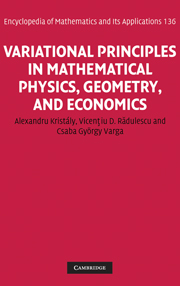 Variational Principles in Mathematical Physics, Geometry, and Economics
Variational Principles in Mathematical Physics, Geometry, and Economics from Part I - Variational principles in mathematical physics
Published online by Cambridge University Press: 05 June 2013
All truths are easy to understand once they are discovered; the point is to discover them.
Galileo Galilei (1564–1642)The study of nonlinear eigenvalue problems for quasilinear operators on unbounded domains involving the p-Laplacian is motivated by various applications. We refer only to fluid mechanics, to mathematical models of the torsional creep, and to non-linear field equations arising in quantum mechanics. For instance, in fluid mechanics, the shear stress and the velocity gradient ∇pu of certain fluids obey a relation of the form (x) = a(x)∇pu(x), where ∇pu ≔∣u∣p−2∇u and p > 1 is an arbitrary real number. The case p = 2 (respectively, p < 2, p > 2) corresponds to a Newtonian (respectively, pseudo-plastic, dilatant) fluid. Then the resulting equations of motion involve div (a∇pu), which reduces to a∆pu = a div (∆pu), provided that a is a constant.
The p-Laplace operator also appears in the study of flows through porous media (p = 3/2, [209]) or glacial sliding (p ∈ (1, 4 /3], [176]). We refer to Aronsson and Janfalk [13] for the mathematical treatment of the Hele-Shaw flow of “power-law fluids.” The concept of Hele-Shaw flow corresponds to a flow between two closely spaced parallel plates, where the gap between the plates is small compared with the dimension of the plates.
To save this book to your Kindle, first ensure [email protected] is added to your Approved Personal Document E-mail List under your Personal Document Settings on the Manage Your Content and Devices page of your Amazon account. Then enter the ‘name’ part of your Kindle email address below. Find out more about saving to your Kindle.
Note you can select to save to either the @free.kindle.com or @kindle.com variations. ‘@free.kindle.com’ emails are free but can only be saved to your device when it is connected to wi-fi. ‘@kindle.com’ emails can be delivered even when you are not connected to wi-fi, but note that service fees apply.
Find out more about the Kindle Personal Document Service.
To save content items to your account, please confirm that you agree to abide by our usage policies. If this is the first time you use this feature, you will be asked to authorise Cambridge Core to connect with your account. Find out more about saving content to Dropbox.
To save content items to your account, please confirm that you agree to abide by our usage policies. If this is the first time you use this feature, you will be asked to authorise Cambridge Core to connect with your account. Find out more about saving content to Google Drive.